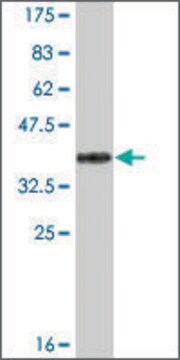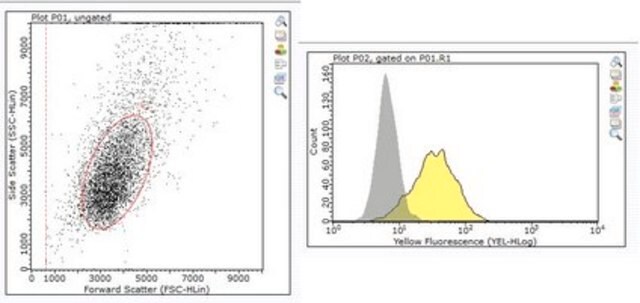05-1098
Anti-acetyl CoA Carboxylase Antibody, clone 7D2.2
clone 7D2.2, from mouse
Synonim(y):
acetyl-CoA carboxylase 1, acetyl-CoA carboxylase-alpha, acetyl-Coenzyme A carboxylase alpha
About This Item
Polecane produkty
pochodzenie biologiczne
mouse
Poziom jakości
forma przeciwciała
purified immunoglobulin
rodzaj przeciwciała
primary antibodies
klon
7D2.2, monoclonal
reaktywność gatunkowa
human, rat
metody
western blot: suitable
izotyp
IgG2aκ
numer dostępu NCBI
numer dostępu UniProt
Warunki transportu
wet ice
docelowa modyfikacja potranslacyjna
unmodified
informacje o genach
human ... ACACA(31)
rat ... Acaca(60581)
Opis ogólny
Immunogen
Zastosowanie
Signaling
Insulin/Energy Signaling
Western Blot (SNAP ID) Analysis: 1 µg/mL from a previous lot detected acetyl CoA Carboxylase on 10 µg of human heart lysate.
Jakość
Western Blot Analysis: 1 µg/mL of this antibody detected acetyl CoA Carboxylase on 10 µg of human heart lysate.
Opis wartości docelowych
Powiązanie
Postać fizyczna
Przechowywanie i stabilność
Komentarz do analizy
Human heart lysate
Inne uwagi
Oświadczenie o zrzeczeniu się odpowiedzialności
Not finding the right product?
Try our Narzędzie selektora produktów.
polecane
Kod klasy składowania
12 - Non Combustible Liquids
Klasa zagrożenia wodnego (WGK)
WGK 1
Temperatura zapłonu (°F)
Not applicable
Temperatura zapłonu (°C)
Not applicable
Certyfikaty analizy (CoA)
Poszukaj Certyfikaty analizy (CoA), wpisując numer partii/serii produktów. Numery serii i partii można znaleźć na etykiecie produktu po słowach „seria” lub „partia”.
Masz już ten produkt?
Dokumenty związane z niedawno zakupionymi produktami zostały zamieszczone w Bibliotece dokumentów.
Nasz zespół naukowców ma doświadczenie we wszystkich obszarach badań, w tym w naukach przyrodniczych, materiałoznawstwie, syntezie chemicznej, chromatografii, analityce i wielu innych dziedzinach.
Skontaktuj się z zespołem ds. pomocy technicznej








